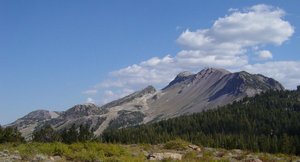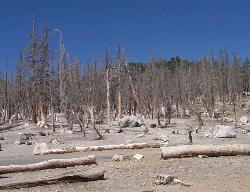Mammoth Mountain
|
|
Template:Mtnbox start Template:Mtnbox coor dms Template:Mtnbox topo Template:Mtnbox volcano Template:Mtnbox climb Template:Mtnbox finish
Mammoth Mountain is a volcano that lies to the west of the town of Mammoth Lakes, California in the Inyo National Forest. Mammoth Mountain is home to the Mammoth Mountain Ski Area which is notable in that it gets an unusually large amount of snow, due to Mammoth Mountain lying in a low gap in the Sierra crest. In the summer months the ski gondolas are used by mountain bikers and tourists who wish to get a spectacular summit view of Long Valley Caldera directly to the east and Sierra peaks to the west, south and north.
The mountain was formed from a long series of eruptions that started about 200,000 years ago and lasted to perhaps 50,000 years ago, although the volcano is still active with minor eruptions; the largest of which was a minor phreatic (steam) eruption 600 years ago. Mammoth Mountain is composed primarily of dacite and rhyolite; some of which have been altered by hydrothermal activity from fumaroles (steam vents). Mammoth lies on the South end of the Mono-Inyo chain of volcanic craters, some of which erupted as recently as 250 years ago.
Mammoth Mountain is on the southwestern edge of Long Valley Caldera, a large area that subsided after an enormous eruption 760,000 years ago. In fact the same magma chamber that was the source of the heat that eventually caused this great eruption also feeds Mammoth Mountain through fissures at the edge of the caldera.
Mammoth is outgassing large amounts of carbon dioxide out of its South flank, near Horseshoe Lake. The concentration of carbon dioxide in the ground reaches over 50%. Measurements of the total discharge of carbon dioxide gas at the Horseshoe Lake tree kill area range from 50-150 tons per day. This high concentration causes trees to die in six regions that total about 170 acres (0.688 km²) in size (see photo, below). Camping has been prohibited in the tree kill area since 1995, to prevent asphyxiation of campers due to accumulation of carbon dioxide in tents and restrooms.
The tree kills originally were attributed to a severe drought that affected California in the late 1980s and early 1990s. Another idea was that the kills were the result of a pathogen or other biological infestation. However neither idea explained why all trees in the affected areas were killed regardless of age or health. Then in March 1990, a United States Forest Service ranger became ill with suffocation symptoms after being in a snow-covered cabin near Horseshoe Lake. Doctors later determined the cause: carbon dioxide poisoning.
Measurements around the lake found that restrooms and tents had a greater than 1% CO2 concentration (toxic), and a deadly 25% concentration of CO2 in a small cabin. CO2 concentrations of less than 1% are typical and healthy in most soils, however soil concentrations of CO2 in the tree kill areas ranged from 20% to 90%. This overabundance of CO2 was found to be the cause of the tree kills because tree roots need to absorb O2 directly and the high CO2 level reduced available O2. Researchers also determined that Mammoth releases about 1,300 tons of CO2 every day. As of 2003 the concentration of carbon dioxide in soil gas at Mammoth Mountain is being monitored on a continuous, year-round basis at four sites - three at Horseshoe Lake and one near the base of Chair 19 at the ski area.
The most likely sources of the CO2 are degassing of intruded magma and gas release from limestone-rich metasedimentary rocks that are heated by magmatic intrusions. The remarkable uniformity in chemical and isotopic composition of the CO2 and accompanying gases at different locations around Mammoth Mountain indicates that there may actually be a large reservoir of gas deep below the mountain from which gas escapes along faults to the surface.
Reference
- Roadside Geology of Northern and Central California, Alt, Hyndman (Mountain Press Publishing Company, Missoula; 2000) ISBN 0-87842-409-1
- USGS Volcano Hazards Program Long Valley Observatory: Carbon Dioxide and Helium Discharge from Mammoth Mountain (http://lvo.wr.usgs.gov/CO2.html) (public domain text)
External links
- Mammoth Mountain Ski Area trail map (http://www.mammothmountain.com/winter/adventures/ski_ride/trail_map/index.cfm)
- USGS Volcano Hazards Program, Long Valley Observatory (http://lvo.wr.usgs.gov/)
- QTVR of tree kill area (http://www.virtualguidebooks.com/SouthCalif/EastOfTheSierra/MammothLakes/CO2HazardAreaMammoth.html)


